I went on my first expedition outside Munich, with a friend on Easter Saturday, to the highest peak of Germany and two nearby beautiful towns.
We first went to the town of Mittenwald, which is 1 1/2 hours south-west of Munich by rail. The town is famous for making violins, handicrafts and the exterior decor of their Bavarian houses. Skiers would probably care more about the fact that the town is right beside a ski mountain range of 2200-metre altitude!
Twenty minutes away by rail was our second stop of Garmisch-Partenkirchen. It also had some nice traditional architecture, but it's more famous as a transit point to the highest peak of Germany called Zugspitz. Mr friend and I rode the cogwheel train to Lake Eibsee, where there were two ways of travelling to the peak. We took the more thrilling option of the cable car which took us to the peak (2962 metres) in 5 minutes or so. Reputedly, Zugspitz is a vantage point for the 4 adjoining countries of Germany, Austria, Italy and Switzerland. Owing to our lack of geographic knowledge, my friend and I could only identify with confidence Germany (through Lake Eibsee) and Austria (as a sign pointed to the city of Innsbruck hidden by one of the mountains). After 10 cold minutes of searching for Italy and Switzerland in vain, we retreated for a coffee then headed downhill via the other travel option. We took the 'Glacier' cable car to the Zugspitzbahn (Zugspitz Rail) terminus where we were joined by a mad rush of skiers returning to Lake Eibsee. Unfortunately a couple of them paid a very expensive way downhill; see my commentary to one of the photos.
It was very easy and affordable to travel around on Deutsche Bahn (German Railway). My friend and I used a 'Schönes Wochenende' ('Nice weekend') ticket which cost 30 euros and allowed unlimited travel on standard DB trains (unfortunately no express trains allowed) plus connecting city transport at the origin and destination for one day, for a maximum of 5 people. It's just too tempting to slip out of town for a day trip! When you're planning your travels within Germany and neighbouring countries, make sure you check the DB web site http://www.bahn.de/ for their many other tickets and deals!
復活節星期六,我跟台灣朋友一同到慕尼黑附近的兩個小鎮及德國第一峰遊玩。
我們坐火車先往離慕尼黑個半小時的Mittenwald,該鎮以製造小提琴及手工藝為名,民居有着傳統巴伐利亞風格,屋外壁畫及佈置也充滿藝術氣息。小鎮毗鄰2200米高的雪山,是滑雪的好去處。
再坐20分鐘火車便到達第二站Garmisch-Partenkirchen,該鎮的建築也不錯,也是前往德國最高峰Zugspitz的出發點。我們坐齒輪火車往Eibsee湖,那裡有兩種方法上山,我們選了乘吊車,不消幾分鐘,隨着風景不斷迅速變遷,便登上2962米高的山頂。Zugspitz號稱可俯瞰德國、奧地利、意大利及瑞士四國,但我和朋友地理知識貧乏,祇能認出德國(全靠Eibsee湖)及奧地利(圖解說明奧地利城市Innsbruck躲在某座山後),意大利及瑞士怎樣也找不到。山頂很冷,十分鐘後我們便躲回室內歎咖啡,然後乘「冰河」吊車往Zugspitzbahn列車站,跟一大伙滑雪者擠下山到Eibsee湖,有幾個滑雪者可真倒霉,下山代價不菲,祇要看看其中一張相片說明便知是甚麼一回事。
在德國及鄰國旅遊,乘火車是方便廉宜之選,我們用30歐元買了一張德國鐵路局「美妙週末」票(Schönes Wochenende),可供最多五人一日內無限次乘搭德鐵普通列車(不包括快車)及起點、終點城市的連接交通,價錢相當吸引,可多多出外玩一天了!德國鐵路局還有其他票種及優惠,計劃旅遊路線時,其網頁http://www.bahn.de/定可幫到你。
Mittenwalt
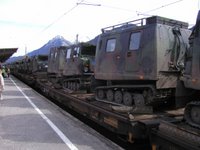
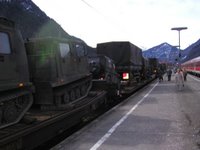
An overt military operation
調兵遺將
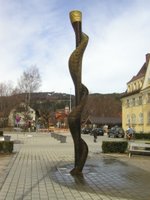

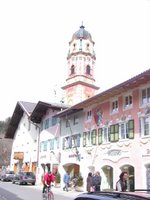
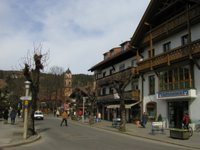
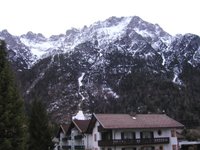
The Karwendel Mountain (2200 m) at Mittenwalt
Mittenwalt毗鄰的雪山Karwendel
Garmisch-Partenkirchen
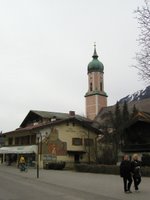
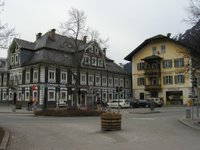
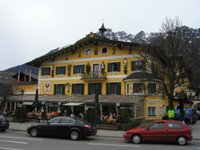
Zugspitz
The view of Zugspitz from bottom to top
登山時的景色
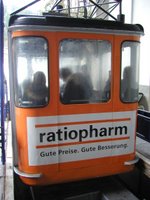
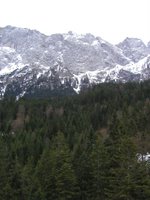
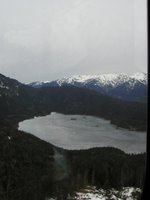
Lake Eibsee (right) Eibsee湖(右)
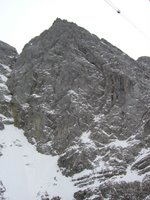

View from the top 山頂的景色
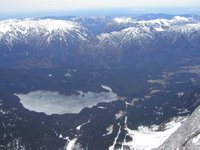
We first went to the town of Mittenwald, which is 1 1/2 hours south-west of Munich by rail. The town is famous for making violins, handicrafts and the exterior decor of their Bavarian houses. Skiers would probably care more about the fact that the town is right beside a ski mountain range of 2200-metre altitude!
Twenty minutes away by rail was our second stop of Garmisch-Partenkirchen. It also had some nice traditional architecture, but it's more famous as a transit point to the highest peak of Germany called Zugspitz. Mr friend and I rode the cogwheel train to Lake Eibsee, where there were two ways of travelling to the peak. We took the more thrilling option of the cable car which took us to the peak (2962 metres) in 5 minutes or so. Reputedly, Zugspitz is a vantage point for the 4 adjoining countries of Germany, Austria, Italy and Switzerland. Owing to our lack of geographic knowledge, my friend and I could only identify with confidence Germany (through Lake Eibsee) and Austria (as a sign pointed to the city of Innsbruck hidden by one of the mountains). After 10 cold minutes of searching for Italy and Switzerland in vain, we retreated for a coffee then headed downhill via the other travel option. We took the 'Glacier' cable car to the Zugspitzbahn (Zugspitz Rail) terminus where we were joined by a mad rush of skiers returning to Lake Eibsee. Unfortunately a couple of them paid a very expensive way downhill; see my commentary to one of the photos.
It was very easy and affordable to travel around on Deutsche Bahn (German Railway). My friend and I used a 'Schönes Wochenende' ('Nice weekend') ticket which cost 30 euros and allowed unlimited travel on standard DB trains (unfortunately no express trains allowed) plus connecting city transport at the origin and destination for one day, for a maximum of 5 people. It's just too tempting to slip out of town for a day trip! When you're planning your travels within Germany and neighbouring countries, make sure you check the DB web site http://www.bahn.de/ for their many other tickets and deals!
復活節星期六,我跟台灣朋友一同到慕尼黑附近的兩個小鎮及德國第一峰遊玩。
我們坐火車先往離慕尼黑個半小時的Mittenwald,該鎮以製造小提琴及手工藝為名,民居有着傳統巴伐利亞風格,屋外壁畫及佈置也充滿藝術氣息。小鎮毗鄰2200米高的雪山,是滑雪的好去處。
再坐20分鐘火車便到達第二站Garmisch-Partenkirchen,該鎮的建築也不錯,也是前往德國最高峰Zugspitz的出發點。我們坐齒輪火車往Eibsee湖,那裡有兩種方法上山,我們選了乘吊車,不消幾分鐘,隨着風景不斷迅速變遷,便登上2962米高的山頂。Zugspitz號稱可俯瞰德國、奧地利、意大利及瑞士四國,但我和朋友地理知識貧乏,祇能認出德國(全靠Eibsee湖)及奧地利(圖解說明奧地利城市Innsbruck躲在某座山後),意大利及瑞士怎樣也找不到。山頂很冷,十分鐘後我們便躲回室內歎咖啡,然後乘「冰河」吊車往Zugspitzbahn列車站,跟一大伙滑雪者擠下山到Eibsee湖,有幾個滑雪者可真倒霉,下山代價不菲,祇要看看其中一張相片說明便知是甚麼一回事。
在德國及鄰國旅遊,乘火車是方便廉宜之選,我們用30歐元買了一張德國鐵路局「美妙週末」票(Schönes Wochenende),可供最多五人一日內無限次乘搭德鐵普通列車(不包括快車)及起點、終點城市的連接交通,價錢相當吸引,可多多出外玩一天了!德國鐵路局還有其他票種及優惠,計劃旅遊路線時,其網頁http://www.bahn.de/定可幫到你。
Mittenwalt


An overt military operation
調兵遺將





The Karwendel Mountain (2200 m) at Mittenwalt
Mittenwalt毗鄰的雪山Karwendel
Garmisch-Partenkirchen



Zugspitz
The view of Zugspitz from bottom to top
登山時的景色



Lake Eibsee (right) Eibsee湖(右)


View from the top 山頂的景色

A bird eye's view of Germany (left) and Austria (right)
從山頂鳥瞰德國(左)及奧地利(右)
Glacier Cable Car
「冰河」吊車
The rush downhill in the Zugspitzbahn train
Zugspitz火車擠滿下山乘客
The Zugspitzbahn train is fitted with ski-hangers, but some skiers did not hang their skis properly. They found out when they heard their pieces of wood fall off and disappear in the tunnel ...
Zugspitz列車外可掛雪橇,但有滑雪者掛不好,列車甫開動便倒下,消失在隧道中。




Comments
Looks absolutely stunning and I love the architecture! Some is v. sterotypical german/swiss and some half wedding cake.